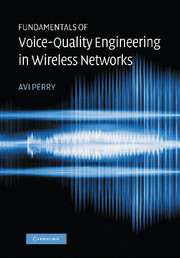Book contents
- Frontmatter
- Contents
- Preface
- List of abbreviations
- Introduction
- Part I Voice-quality foundations
- Part II Applications
- 3 Electrical echo and echo cancelation
- 4 Acoustic echo and its control
- 5 Noisy ambience, mobility, and noise reduction
- 6 Speech-level control
- Part III Wireless architectures
- Part IV A network operator's guide for selecting, appraising, and testing a VQS
- Part V Managing the network
- Part VI Afterthoughts and some fresh ideas
- Part VII Recordings
- Glossary of common voice-quality systems terminology
- Brief summary of echo cancelation and VQS major standards
- Brief summary of key voice-quality assessment standards
- Bibliography
- Index
4 - Acoustic echo and its control
Published online by Cambridge University Press: 24 May 2010
- Frontmatter
- Contents
- Preface
- List of abbreviations
- Introduction
- Part I Voice-quality foundations
- Part II Applications
- 3 Electrical echo and echo cancelation
- 4 Acoustic echo and its control
- 5 Noisy ambience, mobility, and noise reduction
- 6 Speech-level control
- Part III Wireless architectures
- Part IV A network operator's guide for selecting, appraising, and testing a VQS
- Part V Managing the network
- Part VI Afterthoughts and some fresh ideas
- Part VII Recordings
- Glossary of common voice-quality systems terminology
- Brief summary of echo cancelation and VQS major standards
- Brief summary of key voice-quality assessment standards
- Bibliography
- Index
Summary
Introduction
This chapter examines the sources and the reasons for the existence of acoustic echo in wireless networks. It explains how acoustic echo is different from hybrid or electrical echo, and how it can be diagnosed away from its hybrid relative. The chapter follows the description of the impairment by examining the present methods for properly controlling acoustic echo in wireless communications. It also gives details of how background noise makes it more difficult to control acoustic echo properly. It describes those particular impairments that may be set off by some acoustic-echo control algorithms, specifically those built into mobile handsets, and it describes how they can be remedied by proper treatment brought about by means of voice-quality systems (VQS) in the network.
Acoustic echo and its derivatives are common problems facing customers of wireless communications services. Unlike electrical echo, these problems are rarely anticipated during initial deployments of wireless infrastructures because they are supposed to be addressed by handset manufacturers and controlled inside the mobile phone.
Unfortunately, many handset solutions do not control acoustic echo properly. In fact, a considerable number of mobile handsets introduce solutions that exacerbate the impairment by spawning severe side effects in the form of noise clipping and ambiance discontinuity. These side effects are, in most cases, more damaging than the impairment affected by the acoustic echo on its own.
Information
- Type
- Chapter
- Information
- Publisher: Cambridge University PressPrint publication year: 2006
